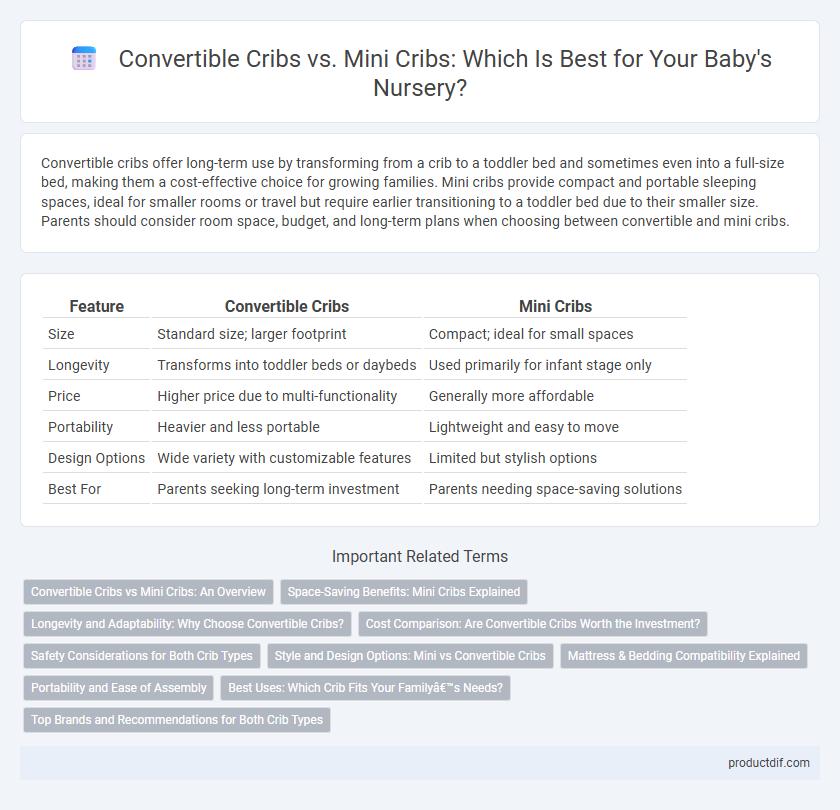Convertible cribs offer long-term use by transforming from a crib to a toddler bed and sometimes even into a full-size bed, making them a cost-effective choice for growing families. Mini cribs provide compact and portable sleeping spaces, ideal for smaller rooms or travel but require earlier transitioning to a toddler bed due to their smaller size. Parents should consider room space, budget, and long-term plans when choosing between convertible and mini cribs.
Table of Comparison
| Feature | Convertible Cribs | Mini Cribs |
|---|---|---|
| Size | Standard size; larger footprint | Compact; ideal for small spaces |
| Longevity | Transforms into toddler beds or daybeds | Used primarily for infant stage only |
| Price | Higher price due to multi-functionality | Generally more affordable |
| Portability | Heavier and less portable | Lightweight and easy to move |
| Design Options | Wide variety with customizable features | Limited but stylish options |
| Best For | Parents seeking long-term investment | Parents needing space-saving solutions |
Convertible Cribs vs Mini Cribs: An Overview
Convertible cribs transform from a crib into a toddler bed, daybed, or even a full-size bed, providing long-term use and cost efficiency for growing children. Mini cribs are compact, offering space-saving benefits ideal for small nurseries, but they often lack the versatility and extended lifespan of convertible cribs. Understanding the trade-offs between size, functionality, and longevity helps parents choose the best crib option for their space and budget needs.
Space-Saving Benefits: Mini Cribs Explained
Mini cribs offer significant space-saving benefits, making them ideal for small nurseries or multi-purpose rooms. Their compact design fits easily into tight spaces while still providing a safe and comfortable sleeping area for babies. Unlike convertible cribs, mini cribs are lightweight and portable, allowing for easy relocation throughout the home.
Longevity and Adaptability: Why Choose Convertible Cribs?
Convertible cribs offer unmatched longevity by transforming from a crib to a toddler bed, daybed, and sometimes even a full-size bed, adapting to a growing child's needs over several years. Mini cribs provide compact convenience but lack the versatile extension options, typically serving effectively only for the infant stage. Investing in a convertible crib ensures cost-effectiveness and prolonged usability, accommodating different growth phases without the need for frequent replacements.
Cost Comparison: Are Convertible Cribs Worth the Investment?
Convertible cribs typically range from $200 to $600, offering long-term value by transforming into toddler beds and sometimes full-sized beds, reducing the need for multiple purchases. Mini cribs, priced between $150 and $300, provide portability and space-saving benefits but require replacement as the child grows, leading to repeated expenses. Investing in a convertible crib is cost-effective for families prioritizing durability and longevity over immediate savings.
Safety Considerations for Both Crib Types
Convertible cribs and mini cribs both meet rigorous safety standards, but convertible cribs often feature adjustable mattress heights and sturdier construction for long-term use. Mini cribs provide a compact sleeping solution ideal for small spaces while maintaining essential safety elements such as fixed slats and non-toxic finishes. Ensuring compliance with the latest Consumer Product Safety Commission (CPSC) regulations is critical for both crib types to prevent hazards like falls, entrapment, and toxic exposure.
Style and Design Options: Mini vs Convertible Cribs
Convertible cribs offer versatile style options with adjustable designs that grow with the child, often featuring classic and modern aesthetics to complement various nursery themes. Mini cribs prioritize compactness and portability, showcasing streamlined, minimalist designs suitable for small spaces and temporary setups. Both options provide durable materials and finishes that enhance safety while aligning with different parental preferences in nursery decor.
Mattress & Bedding Compatibility Explained
Convertible cribs offer versatile mattress compatibility, accommodating standard-sized crib mattresses that often range from 52 x 28 inches, while mini cribs require smaller mattresses typically measuring around 38 x 24 inches, making bedding options more limited. Mattress thickness and firmness standards for both crib types follow safety guidelines to ensure infant comfort and reduce SIDS risk, but convertible crib bedding sets usually provide more variety and long-term usability. Families should verify exact mattress dimensions and bedding fit for each crib model to guarantee proper safety and comfort for their baby's sleep environment.
Portability and Ease of Assembly
Convertible cribs typically offer a sturdy design but are less portable due to their larger size and more complex assembly requiring multiple tools. Mini cribs excel in portability with lightweight frames and compact dimensions, making them ideal for small spaces and easy diaper changes on the go. Assembly for mini cribs is generally straightforward, featuring fewer parts and quick setup mechanisms that save time for busy parents.
Best Uses: Which Crib Fits Your Family’s Needs?
Convertible cribs offer long-term value by transforming from a crib to toddler and sometimes full-size beds, making them ideal for growing families seeking durability and cost-effectiveness. Mini cribs are perfect for small spaces or as a secondary sleeping option, providing portability and compact design without sacrificing safety. Families should consider room size, budget, and future needs when choosing between the versatility of convertible cribs and the convenience of mini cribs.
Top Brands and Recommendations for Both Crib Types
Top brands offering convertible cribs include Graco, DaVinci, and Delta Children, known for durability and multi-stage use from infant to toddler beds. Mini cribs are prominently featured by brands like Babyletto, Stokke, and Arm's Reach, praised for space-saving design and portability. Consumer recommendations highlight convertible cribs for long-term value and investment, while mini cribs appeal to parents seeking compact solutions for small spaces or travel.
Convertible Cribs vs Mini Cribs Infographic

 productdif.com
productdif.com